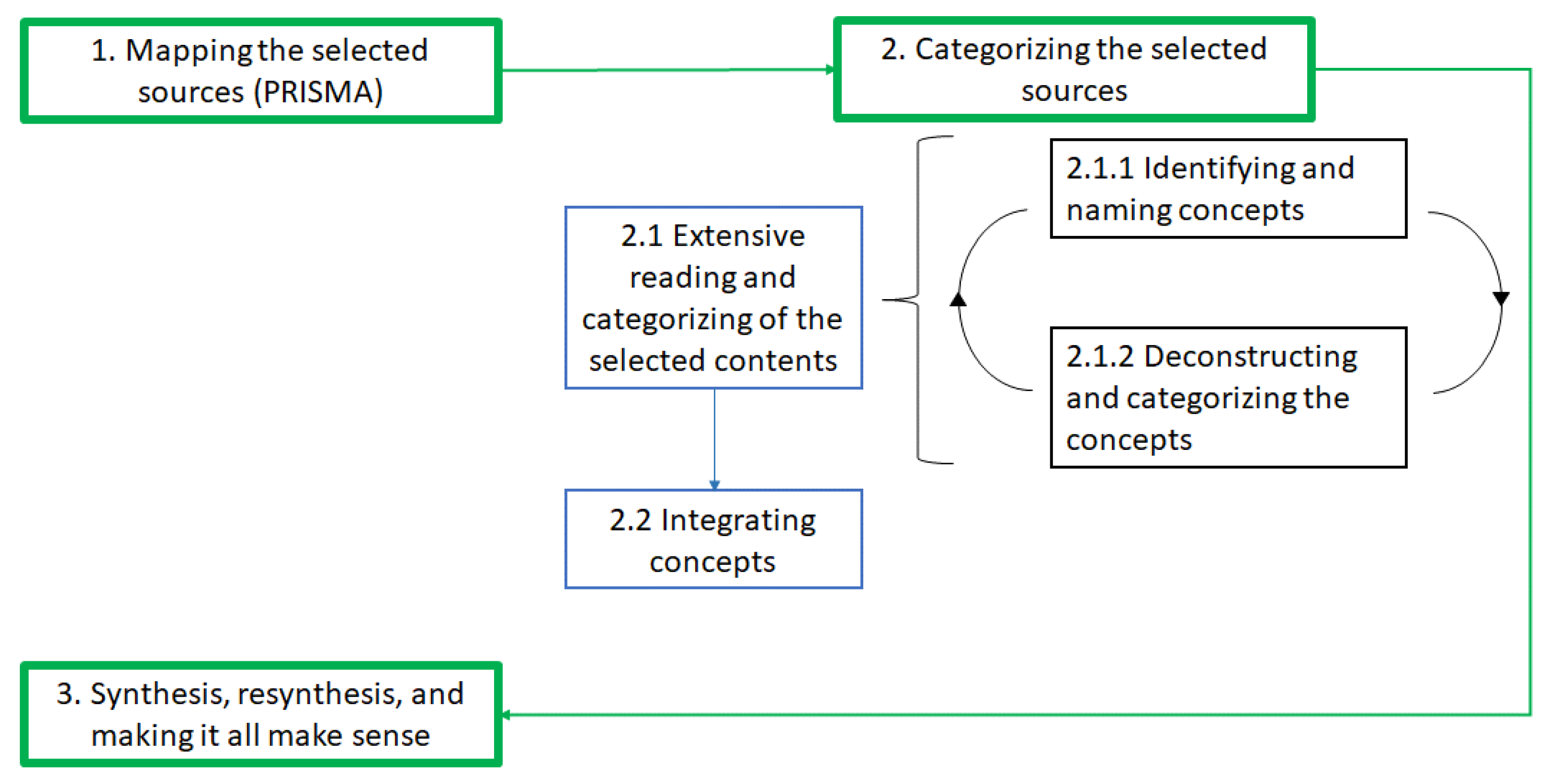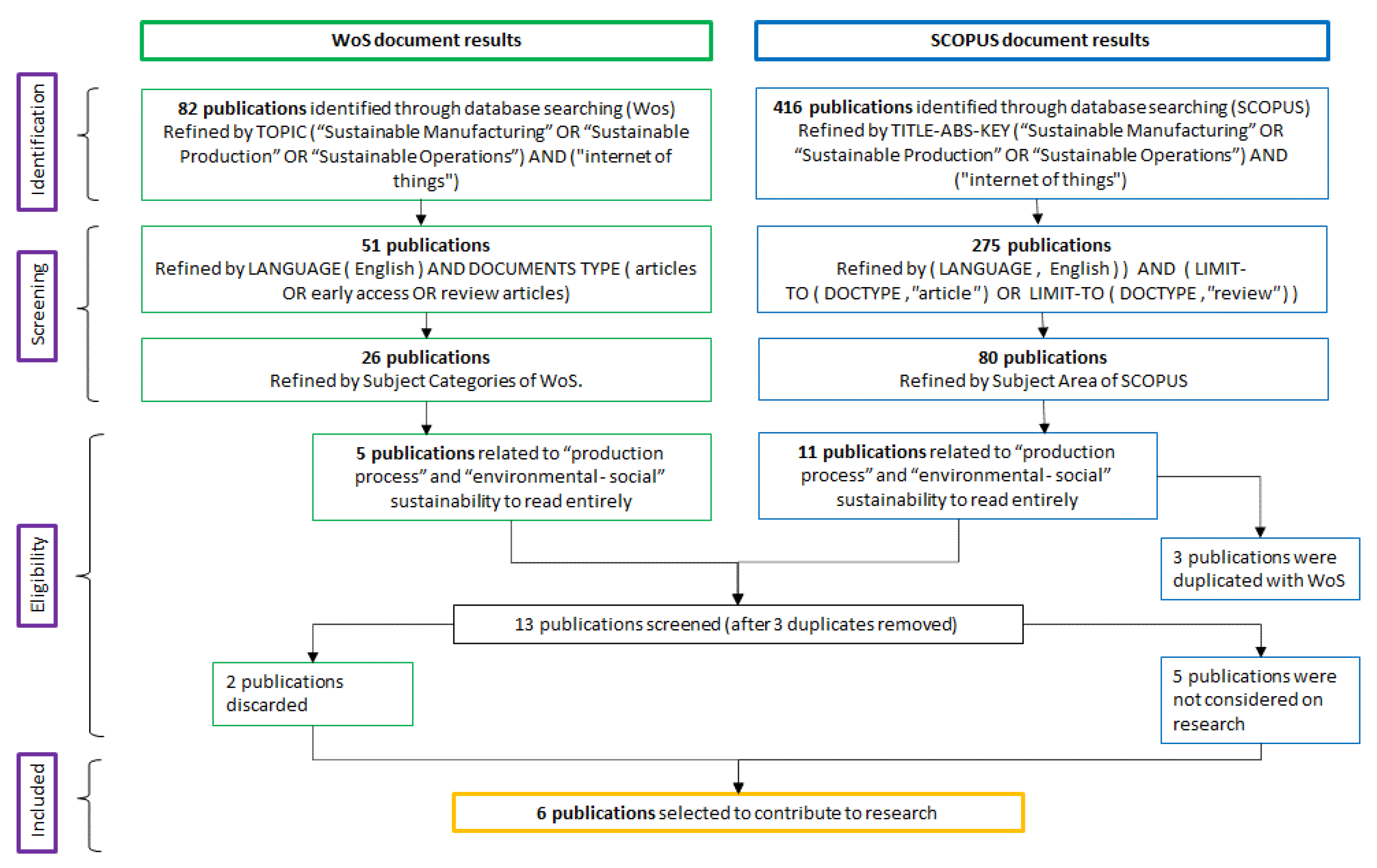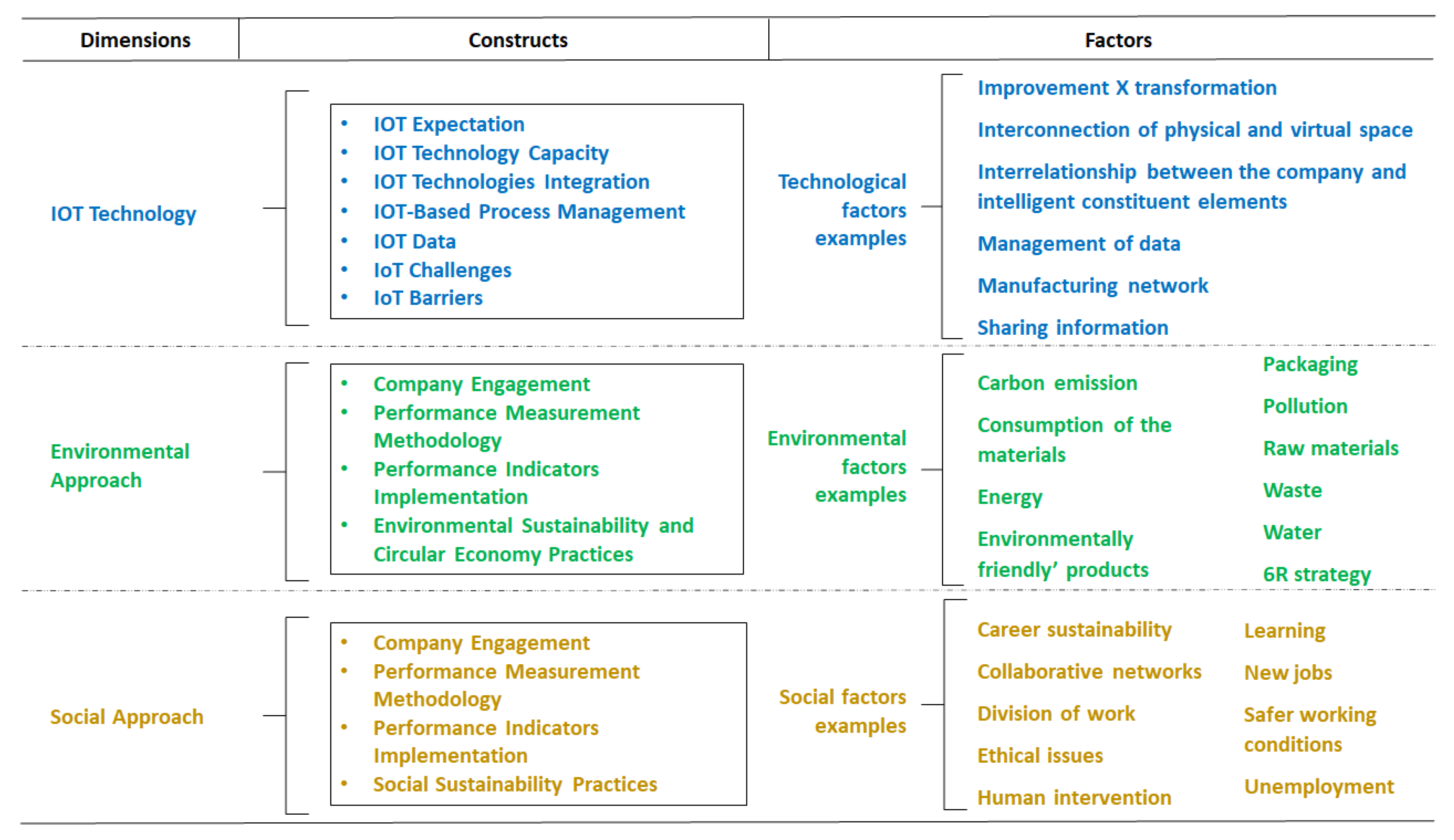A Conceptual Model Proposal to Assess the Effectiveness of IoT in Sustainability Orientation in Manufacturing Industry: An Environmental and Social Focus
Abstract
:1. Introduction
2. Methodology
- Mapping of the selected sources: carrying out a systematic literature review applying the PRISMA process, focusing on the IoT and sustainable manufacturing (environmental and social sustainability) and the identification of contents or statements related to empirical facts and practices.
- Categorizing the selected sources:
- 2.1
- Extensive reading and categorization of selected content by reading selected literature and categorizing the content into dimensions and representative constructs with each dimension.
- 2.1.1
- Identify and name concepts: review selected content allowing concepts to emerge from the literature.
- 2.1.2
- Deconstruct and categorize the concepts: identify the main attributes, characteristics, assumptions and roles of concepts and, later, organize and categorize them according to their features.
- 2.2
- Integration of concepts: integrate and group concepts that have similarities to a new one, manipulating the concepts to give a reasonable number.
- Synthesis, resynthesis and making sense: conducting an iterative process that includes repetitive synthesis and resynthesis, until the researcher recognizes a CM that makes sense.
3. Results
3.1. Mapping the Selected Sources: PRISMA
3.1.1. Identification Phase
3.1.2. Screening Phase
3.1.3. Eligibility Phase
- Two articles were discarded: one was related to life cycle assessment (LCA) and other article concerned lean manufacturing and healthcare. Both subjects were out of the scope of this work.
- Three articles were duplicates of articles in WoS. Two of these were discarded as mentioned earlier, and the article by Li et al. [17] was selected to contribute to the study.
- Five articles were not considered in the research. Two articles were discarded, as one was concerned with manufacturing process modeling and other was out of the industry context. One article was not free and another proposed the design of a business maturity scheme for companies implementing Industry 4.0. Finally, another article focused on manufacturing resiliency and sustainability.
3.1.4. Inclusion Phase
3.2. Categorizing the Selected Sources
- Dimensions: the three principal dimensions to be assessed were IoT technology, environmental approaches and social approaches.
- Constructs:
- The seven constructs for IoT technology were: IoT expectations, IoT technology capacity, IoT technologies integration, IoT-based process management, IoT data, IoT challenges and IoT barriers.
- The four constructs for environmental approaches were: company engagement, performance measurement methodology, performance indicators implementation and environmental sustainability and circular economy practices.
- The four constructs for social approaches were: company engagement, performance measurement methodology, performance indicators implementation and social sustainability practices.
- Factors to be assessed/measured by the indicators, which should fit the statements and their definitions related to the construct.
3.3. Synthesis and Resynthesis: The Statements and Their Dimensions, Constructs and Factors
3.3.1. IoT Technology
- IoT Technology Expectation
- IoT Technology Capacity
- IoT Technologies Integration
- IoT-Based Process Management
- IoT Data
- IoT Challenges
- IoT Barriers
3.3.2. Environmental Approach
- Company Engagement
- Performance Measurement Methodology
- Performance Indicators Implementation
- Environmental Sustainability and Circular Economy Practices
3.3.3. Social Approach
- Company Engagement
- Performance Measurement Methodology
- Performance Indicators Implementation
- Social Sustainability Practices
3.3.4. The Conceptual Model
4. Discussion
5. Theoretical and Managerial Contributions
- The measurement and evaluation of performance in Industry 4.0 within the scope of sustainability and the circular economy.
- The effect of IoT technologies in approaching the circular economy on themes such as input reduction, consumption, reuse, recovery, recycling and waste and emissions reduction.
- Exploring the benefits and challenges within organizations on how to implement and adopt the IoT and environmental and social sustainability in its operations and supply chains.
- The CM, which should help the organization to engage employees in assessing the effectiveness of IoT technologies with a focus on socio-environmental sustainability.
- The focus on socio-environmental sustainability, which can lead to new or revised measures that improve the organization’s sustainability performance.
6. Research Limitations
7. Suggestions for Future Research
- The validation of the CM, according to Jabareen [15] (p. 54), to certify “whether the proposed framework and its concepts make sense not only to the researcher but also to other scholars and practitioners (…) is a process that starts with the researcher, who then seeks validation among ‘outsiders’”. The researches can receive feedback, new insights and comments from expert opinions—the “outsiders”—by consensus methods such as the Delphi Method “to gather general agreement on topics that do not yet have empirical evidence to support future decisions or actions; often, these topics are ambiguous or controversial” [28] (p. 663). The Delphi method has advantages for obtaining consensus from other methods as “it eliminates the bias and influence that can occur in face-to-face meetings as the respondents are to remain anonymous, (…) the ranking of each item by the entire response group helps make the ultimate conclusions more reliable than a single meeting, (…) does not require specified meeting times” [28] (p. 666).
- The translation of the statements into a management tool to assess whether IoT technologies are oriented towards socio-environmental sustainability and circular economy approaches in manufacturing industries. The management tool can be a questionnaire using a five-point Likert scale via the online platform SurveyMonkey and/or interviews. The results should contribute to the management practices as an input to the planning and implementation of IoT technologies oriented towards sustainability and the circular economy approach. In addition, the results contribute to the scientific–academic environment, because there is a demand for empirical studies on, for example, the impacts of digital transformation on the environmental and social domains of sustainability, the relationship between organizational performance and digitalization of environmental sustainability practices and digital transformation strategies integrated with sustainability pillars in manufacturing.
- The application of this management tool in a pilot study aimed at a specific industrial sector to investigate, for example, the differences in the socio-environmental effectiveness of the IoT in small, medium and large organizations in a certain sector.
Author Contributions
Funding
Institutional Review Board Statement
Informed Consent Statement
Data Availability Statement
Acknowledgments
Conflicts of Interest
References
- Xavier, A.; Reyes, T.; Aoussat, A.; Luiz, L.; Souza, L. Eco-Innovation Maturity Model: A Framework to Support the Evolution of Eco-Innovation Integration in Companies. Sustainability 2020, 12, 3773. [Google Scholar] [CrossRef]
- Garetti, M.; Taisch, M. Sustainable Manufacturing: Trends and Research Challenges. Prod. Plan. Control 2012, 23, 83–104. [Google Scholar] [CrossRef]
- Hallinger, P. Analyzing the intellectual structure of the Knowledge base on managing for sustainability, 1982–2019: A meta-analysis. Sustain. Dev. 2020, 28, 1493–1506. [Google Scholar] [CrossRef]
- Mathiyazhagan, K.; Mani, V.; Mathivathanan, D.; Rajak, S. Evaluation of Antecedents to Social Sustainability Practices in Multi-Tier Indian Automotive Manufacturing Firms. Int. J. Prod. Res. 2021, 1–22. [Google Scholar] [CrossRef]
- Malek, J.; Desai, T.N. A Systematic Literature Review to Map Literature Focus of Sustainable Manufacturing. J. Clean. Prod. 2020, 256, 120345. [Google Scholar] [CrossRef]
- Howard, M.C. Sustainable Manufacturing Initiative (SMI): A True Public-Private Dialogue. Available online: https://www.oecd.org/sti/ind/45010349.pdf (accessed on 30 September 2021).
- OECD. About Sustainable Manufacturing and the Toolkit; Organisation for Economic Co-operation and Development: Paris, France; Available online: http://t4.oecd.org/innovation/green/toolkit/aboutsustainablemanufacturingandthetoolkit.htm#:~:text=The%20OECD%20Sustainable%20Manufacturing%20Toolkit%20aims%20to%20provide,to%20contribute%20to%20sustainable%20development%20and%20green%20growth (accessed on 30 September 2021).
- Laskurain-Iturbe, I.; Arana-Landín, G.; Landeta-Manzano, B.; Uriarte-Gallastegi, N. Exploring the Influence of Industry 4.0 Technologies on the Circular Economy. J. Clean. Prod. 2021, 321, 128944. [Google Scholar] [CrossRef]
- Li, Y.; Dai, J.; Cui, L. The Impact of Digital Technologies on Economic and Environmental Performance in the Context of Industry 4.0: A Moderated Mediation Model. Int. J. Prod. Econ. 2020, 229, 107777. [Google Scholar] [CrossRef]
- Sharma, M.; Joshi, S. Digital Supplier Selection Reinforcing Supply Chain Quality Management Systems to Enhance Firm’s Performance. TQM J. 2020. [Google Scholar] [CrossRef]
- Haddud, A.; DeSouza, A.; Khare, A.; Lee, H. Examining Potential Benefits and Challenges Associated with the Internet of Things Integration in Supply Chains. JMTM 2017, 28, 1055–1085. [Google Scholar] [CrossRef]
- Cavalieri, A.; Reis, J.; Amorim, M. Circular Economy and Internet of Things: Mapping Science of Case Studies in Manufacturing Industry. Sustainability 2021, 13, 3299. [Google Scholar] [CrossRef]
- Tambare, P.; Meshram, C.; Lee, C.-C.; Ramteke, R.J.; Imoize, A.L. Performance Measurement System and Quality Management in Data-Driven Industry 4.0: A Review. Sensors 2022, 22, 224. [Google Scholar] [CrossRef] [PubMed]
- Melnyk, S.A.; Bititci, U.; Platts, K.; Tobias, J.; Andersen, B. Is Performance Measurement and Management Fit for the Future? Manag. Account. Res. 2014, 25, 173–186. [Google Scholar] [CrossRef]
- Jabareen, Y. Building a Conceptual Framework: Philosophy, Definitions, and Procedure. Int. J. Qual. Methods 2009, 8, 49–62. [Google Scholar] [CrossRef]
- Moher, D.; Liberati, A.; Tetzlaff, J.; Altman, D.G.; The PRISMA Group. Preferred Reporting Items for Systematic Reviews and Meta-Analyses: The PRISMA Statement. BMJ 2009, 339, b2535. [Google Scholar] [CrossRef] [Green Version]
- Li, K.; Zhou, T.; Liu, B. Internet-Based Intelligent and Sustainable Manufacturing: Developments and Challenges. Int. J. Adv. Manuf. Technol. 2020, 108, 1767–1791. [Google Scholar] [CrossRef]
- Abubakr, M.; Abbas, A.T.; Tomaz, I.; Soliman, M.S.; Luqman, M.; Hegab, H. Sustainable and Smart Manufacturing: An Integrated Approach. Sustainability 2020, 12, 2280. [Google Scholar] [CrossRef] [Green Version]
- Feroz, A.K.; Zo, H.; Chiravuri, A. Digital Transformation and Environmental Sustainability: A Review and Research Agenda. Sustainability 2021, 13, 1530. [Google Scholar] [CrossRef]
- Pasi, B.N.; Mahajan, S.K.; Rane, S.B. The Current Sustainability Scenario of Industry 4.0 Enabling Technologies in Indian Manufacturing Industries. Int. J. Prod. Perform. Manag. 2021, 70, 1017–1048. [Google Scholar] [CrossRef]
- Sartal, A.; Bellas, R.; Mejías, A.M.; García-Collado, A. The Sustainable Manufacturing Concept, Evolution and Opportunities within Industry 4.0: A Literature Review. Adv. Mech. Eng. 2020, 12, 168781402092523. [Google Scholar] [CrossRef]
- Cavalieri, A.; Macedo-Soares, T.D.v.A.; Thiollent, M. Avaliando o Desempenho da Universidade; Editora PUC-Rio; Edições Loyola: São Paulo, Brazil, 2004; Volume 18, ISBN 85-15-02999-5. [Google Scholar]
- Cavalieri B., A.M. Avaliação do Desempenho da Universidade no Brasil: Um Instrumento de Auto-Avaliação Focando no Ensino e na Gestão; Programa de Engenharia de Produção, 2001; Tese, Universidade Federal do Rio de Janeiro (COPPE/UFRJ): Rio de Janeiro, Brazil, 2001. [Google Scholar]
- Waibel, M.W.; Steenkamp, L.P.; Moloko, N.; Oosthuizen, G.A. Investigating the Effects of Smart Production Systems on Sustainability Elements. Procedia Manuf. 2017, 8, 731–737. [Google Scholar] [CrossRef]
- Mörth, O.; Eder, M.; Holzegger, L.; Ramsauer, C. IoT-Based Monitoring of Environmental Conditions to Improve the Production Performance. Procedia Manuf. 2020, 45, 283–288. [Google Scholar] [CrossRef]
- Lopes, M.A.; Martins, R.A. Mapping the Impacts of Industry 4.0 on Performance Measurement Systems. IEEE Latin Am. Trans. 2021, 19, 1912–1923. [Google Scholar] [CrossRef]
- Hwang, G.; Lee, J.; Park, J.; Chang, T.-W. Developing Performance Measurement System for Internet of Things and Smart Factory Environment. Int. J. Prod. Res. 2017, 55, 2590–2602. [Google Scholar] [CrossRef]
- Waggoner, J.; Carline, J.D.; Durning, S.J. Is There a Consensus on Consensus Methodology? Descriptions and Recommendations for Future Consensus Research. Acad. Med. 2016, 91, 663–668. [Google Scholar] [CrossRef] [PubMed]



| Dimension | Construct | Indicators | Indicator Definitions | Source |
|---|---|---|---|---|
| IoT Technology | IoT expectations |
|
| [19] |
| IoT technology capacity |
|
| [17,18,20] | |
| IoT technologies integration |
|
| [18,20,21] | |
| IoT-based process management |
|
| [17] | |
| IoT data |
|
| [17] | |
| IoT challenges |
|
| [17] | |
| IoT barriers |
|
| [20] |
| Dimension | Construct | Indicators | Indicator Definitions | Source |
|---|---|---|---|---|
| Environmental Approach | Company engagement |
|
| [18,19,21] |
| Performance measurement methodology |
|
| [18,21] | |
| Performance indicators implementation |
|
| [17,18,19,20,21,24] | |
| Environmental sustainability and circular economy practices |
|
| [17,18,19,20,21,24] |
| Dimension | Construct | Indicators | Indicator Definitions | Source |
|---|---|---|---|---|
| Social Approach | Company engagement |
|
| [18,20,21] |
| Performance measurement methodology |
|
| [18,21] 1 | |
| Performance indicators implementation |
|
| [18,21] | |
| Social sustainability practices |
|
| [18,20,21] |
Publisher’s Note: MDPI stays neutral with regard to jurisdictional claims in published maps and institutional affiliations. |
© 2022 by the authors. Licensee MDPI, Basel, Switzerland. This article is an open access article distributed under the terms and conditions of the Creative Commons Attribution (CC BY) license (https://creativecommons.org/licenses/by/4.0/).
Share and Cite
Cavalieri, A.; Reis, J.; Amorim, M. A Conceptual Model Proposal to Assess the Effectiveness of IoT in Sustainability Orientation in Manufacturing Industry: An Environmental and Social Focus. Appl. Sci. 2022, 12, 5661. https://doi.org/10.3390/app12115661
Cavalieri A, Reis J, Amorim M. A Conceptual Model Proposal to Assess the Effectiveness of IoT in Sustainability Orientation in Manufacturing Industry: An Environmental and Social Focus. Applied Sciences. 2022; 12(11):5661. https://doi.org/10.3390/app12115661
Chicago/Turabian StyleCavalieri, Adriane, João Reis, and Marlene Amorim. 2022. "A Conceptual Model Proposal to Assess the Effectiveness of IoT in Sustainability Orientation in Manufacturing Industry: An Environmental and Social Focus" Applied Sciences 12, no. 11: 5661. https://doi.org/10.3390/app12115661
APA StyleCavalieri, A., Reis, J., & Amorim, M. (2022). A Conceptual Model Proposal to Assess the Effectiveness of IoT in Sustainability Orientation in Manufacturing Industry: An Environmental and Social Focus. Applied Sciences, 12(11), 5661. https://doi.org/10.3390/app12115661








